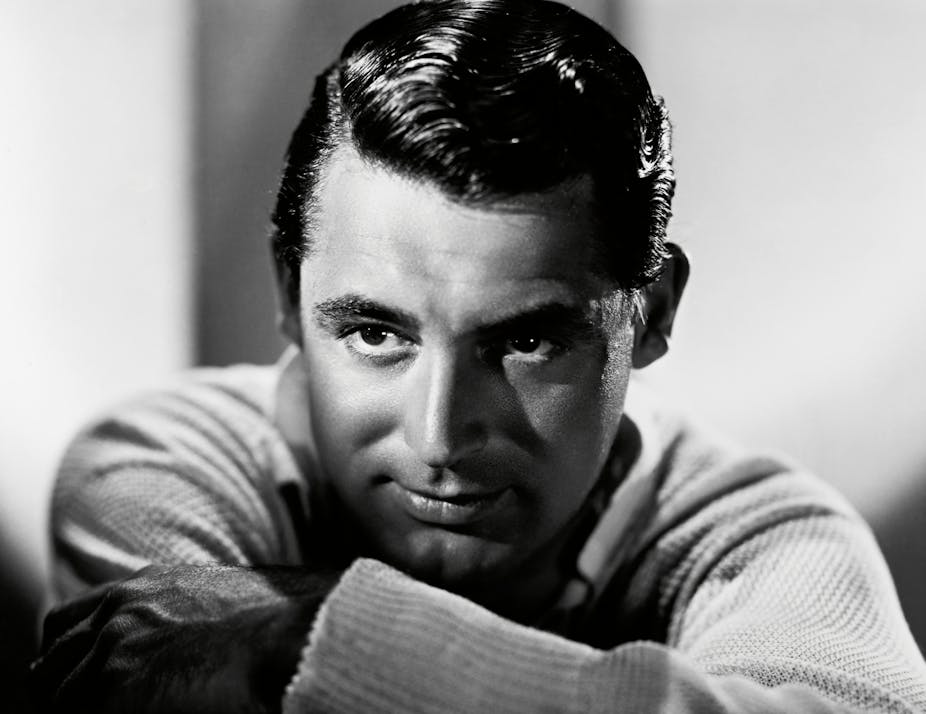Like most of the enduring stars of golden age Hollywood, Cary Grant can be reduced rather effectively to a single image. Marilyn Monroe has her white dress. Humphrey Bogart has his trench coat and trilby. And Grant has his debonair suit, his glasses and his immaculate side parting.
This is one of the quintessential images of modern masculinity. Sexy but never brutish. Graceful without being delicate. Grant was “dashingly handsome, suave and sophisticated” – at least according to the press notes accompanying ITV’s new four-part miniseries, Archie.
As the title suggests, Archie (Grant was born Archibald Alec Leach) promises to expose the double life of one of the most enduringly popular actors of the 20th century. It delves into his impoverished English upbringing in Bristol, his complex relationship with his mother, and his ongoing use of LSD – all in an attempt to reveal the real man behind the famous image.
The series is likely to provoke debates about whether the narratives surrounding Grant obscure important aspects of his identity. Most notably, it seems to avoid longstanding questions over Grant’s sexuality, and the important relationships he maintained with both men and women across his life.
Grant’s sexuality
In July 2023, Grant’s daughter Jennifer, who serves as an executive producer on the ITV series, denied longstanding rumours that her father was either gay or bisexual. Such stories had persisted since his death in 1986, most notably in the attention given to Grant’s relationship with the actor Randolph Scott, who he lived with for 12 years.
Some claim that Grant’s close relationship with Scott is evidence of a secret identity that was in contrast with his public persona. Others have dismissed these claims as an over-interpretation of a narrative created by Hollywood to promote both Grant and Scott as eligible bachelors.

Becoming Cary
Archie, like other recent biopics of Hollywood icons such as Judy (2019) and Blonde (2022), seems to want to perform a collective atonement on behalf of society, revealing the torment and angst behind one of Hollywood’s larger-than-life icons. But the whole point of being larger-than-life is that the persona a star takes on can burn brighter than the story of any real person.
In the case of Grant, his ability to embody modern masculinity allowed audiences not just to celebrate that idea, but to use him as a testing ground for some of the psychological and cultural challenges of the 20th century. His films offer complicated and contrasting visions of what it means to be a man. This allowed him to function as a stand-in for the troubled position of the modern man in a world of fluctuating gender roles.
In three of his most well-known comedies, (Monkey Business, Bringing Up Baby and I Was a Male War Bride), Grant dons womens’ clothing“. The image of such an obvious figure of masculinity wearing a frilly nightgown was undoubtedly meant to make audiences laugh.
Such films might cause modern viewers to wince at their outdated attitudes to sexuality and gender. But there is also something delightfully subversive about them, revelling in Grant’s ability to remain at ease even when his entire manhood is called into question by the characters surrounding him.
In his work with Alfred Hitchcock, Grant was able to use the confidence and bravado displayed in his earlier work to serve darker storytelling themes. In North by Northwest (1959), perhaps their most famous collaboration, Grant becomes an ageing figure of virility seeking to cling on to power and authority, even as the world around him conspires to take it away from him. Grant’s performance – anxious and paranoid – exposes the effort that being a "modern man” often entails.
Grant has played bachelors, divorcees, spies and even a mock turtle. In doing so, he never presented a simple or single vision of masculinity – rather, his performances exposed its many fractures, schisms and points of tension. And they were also a reminder of masculinity’s ongoing appeal, despite all the things that are wrong with it.
Stardom is often at its most potent when different groups of people can find different things in the same figure. For many, Grant remains masculinity incarnate. Others see him as a man who performed a masculine role in order to mask a rawer identity concealed beneath. The brilliance of his star power is that he could be both, and neither. What Grant represented, and the Hollywood persona he built, endures because of these ambiguities, not in spite of them.

Looking for something good? Cut through the noise with a carefully curated selection of the latest releases, live events and exhibitions, straight to your inbox every fortnight, on Fridays. Sign up here.

